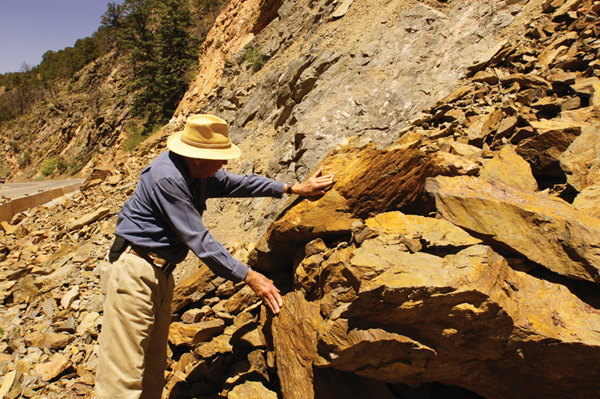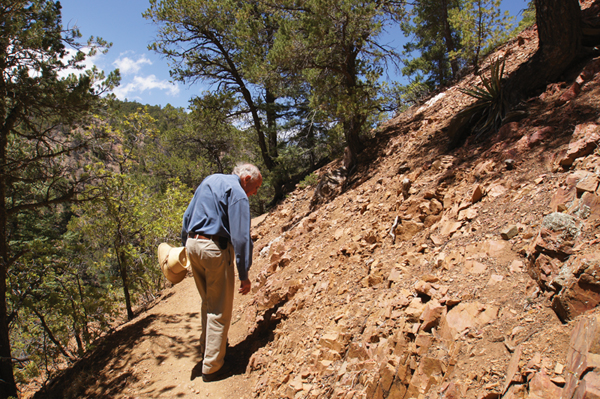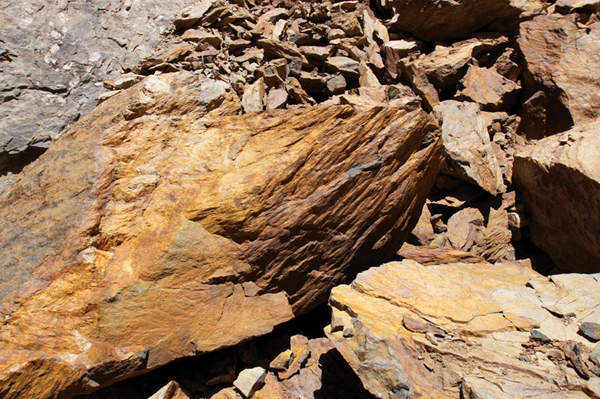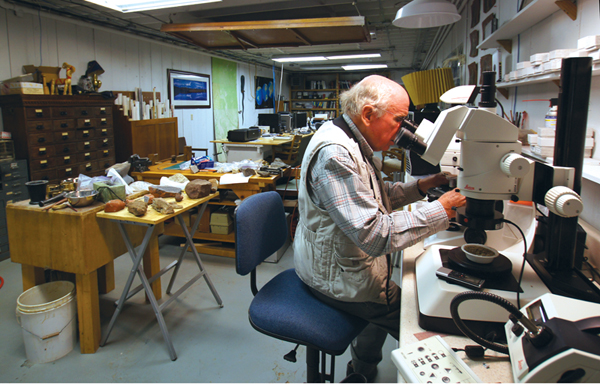
by Annika Wallendahl Thursday, January 5, 2012

Tim McElvain stands with the Santa Fe impact structure shatter cones along Highway 475. Annika Wallendahl

Along the Chamisa Trail, a popular hiking destination about a 15-minute drive northeast of Santa Fe, Tim McElvain found the first Santa Fe shatter cones in 2003. Annika Wallendahl

One of the definitive shatter cones revealed by a rockslide on Highway 475. Annika Wallendahl

Tim McElvain spent countless hours over close to a decade poring over the evidence of the Santa Fe impact. Annika Wallendahl
In the ancient pink and orange hills of the Sangre de Cristo Mountains, Thornton “Tim” McElvain, a retired petroleum geologist, leads me over a concrete highway barrier to a towering granite road cut. McElvain steps onto a rock pile and points to a meter-long block of granite, the freshest offering to fall from the rock face. One side of the block tapers roughly to the shape of a cone, with grooves coming together to form a point.
“This is the best shatter cone example I’ve seen here,” McElvain says.
More than just another neat rock, a shatter cone is a telltale sign that you are standing where a large meteorite once hit. The cones are millimeter- to meter-sized features, with striations that radiate from the cone apex across curved fracture planes. In well-developed shatter cones, the curved fracture planes are continuous and form a 360-degree cone. Found all over the world, but by no means common, shatter cones are sought by impact scientists, geologists and amateur enthusiasts alike. A shatter cone is, after all, a fossilized shockwave.
How McElvain found this group of shatter cones is a story of serendipity: a geological journey that begins, after his retirement, in the French village of Rochechouart and ends with McElvain confirming the discovery of a previously unknown impact structure near Santa Fe, N.M., in 2008.
I first met McElvain at the Santa Fe home he shares with wife IngMarie and two Jack Russell terriers, Snowy and Tin Tin. A longtime New Mexican, McElvain moved to Santa Fe from Texas more than 50 years ago. In 1998, after 40 years as president of an oil and gas exploration company, the soft-spoken McElvain retired from reviewing development proposals. That same year, he and his wife took a vacation to southern France. With no particular destination in mind, they eventually settled on Rochechouart.
Rochechouart is a small country town that offers relaxation, natural beauty and a 13th century castle to explore. It was built within a 23-kilometer-wide meteorite impact structure that formed 200 million years ago, and the castle itself was constructed with impact breccia forged by the impact. On a guided walking tour of this idyllic area, McElvain first laid eyes on a shatter cone, and the road to the Santa Fe impact discovery began.
McElvain found his way to the small impact museum in Rochechouart. Around the world, there are a handful of these museums. In their rooms and hallways, you can find samples of shatter cones, impact breccia, impact glass and other geologic calling cards of past impact events. These rocks all have something in common: They owe their existence to the high-pressure shockwaves created when a meteorite hits Earth. In less than the blink of an eye, shockwaves form at the point of impact and expand outward, vaporizing, melting, excavating and fracturing rock, in a geological process called shock metamorphism.
Impact events create conditions not found anywhere else in the Earth’s crust. They can leave behind gaping craters, like Meteor Crater in Arizona. But more often than not, due to geologic processes over millions to billions of years, the physical shape of an impact crater is erased and only the shocked rocks remain, hidden under or within a younger landscape.
During impact events, rock temperatures can reach 2,000 degrees Celsius with pressures reaching 100 gigapascals. In comparison, during conventional terrestrial metamorphism, temperatures remain below 1,200 degrees Celsius, and pressures remain below three gigapascals. Impact events also create a strain rate — a measure of deformation over time — that is more than seven orders of magnitude greater than those produced during normal tectonics.
Shock metamorphism leaves behind a suite of unique markers in the form of minerals, rocks, structures and geochemical signatures. For the geologist on the ground, in the absence of obvious meteorite fragments, there is only one field marker visible with the naked eye: the shatter cone.
Returning home from France, McElvain took up fieldwork in New Mexico — just for fun. Spending time in the field was, after all, the whole reason he studied geology in the first place. He began walking the hills around Santa Fe and mapping the rocks underfoot. If there ever were a place to find tortured rocks, this would be it. “The whole place is very messy,” McElvain says.
Just north of Santa Fe, the southern Rockies dwindle into the Sangre de Cristo Range. This area has experienced multiple tectonic episodes since the ancient granite crystallized 1.2 billion years ago: the uplift of the Ancestral Rockies, the Laramide Orogeny, the Rio Grande Rift and the Rocky Mountain uplift, just to name a few. Pegmatite veins, faults and breccia dikes cut through the area. Amid all of this noise in the geologic record, McElvain found rocks just like the shatter cones he had seen in France. There was no crater, but there were other, more subtle signs that an impact had occurred here too.
McElvain set out to make his case. He contacted researchers at the University of New Mexico, the University of Utah and the University of Northern Colorado with news of his findings. He assembled an album of photos of possible shatter cones he had found, and brought the album to professional geology meetings. He talked to experts in the field and sent them rock samples. He took a course in impact studies, and joined the Impact Field Studies Group, a research organization that visits impact sites around the world.
McElvain credits Bevan French, an adjunct scientist at the Smithsonian National Museum of Natural History in Washington, D.C., with being one of the researchers who encouraged his work. French has been an active researcher in the field of impact science since the 1960s. He and McElvain met at the 2006 Geological Society of America annual meeting in Philadelphia, Pa., where French suggested that McElvain get a petrographic microscope and begin to look for shocked minerals that would provide additional mineralogical evidence that the rocks were created during an impact event. In rocks that have been metamorphosed by a shockwave, quartz mineral grains develop micron-scale parallel cracks called planar deformation features, or PDFs. In shatter cones, PDFs can be found in quartz grains on the outer cone surfaces.
McElvain used three different kinds of rock microscope to search for shocked quartz from the possible impact structure. If McElvain found a quartz grain that showed potential for having been shocked, he sent the grain mount sample to an outside laboratory to be made into a thin section so he could search for PDFs. He often had to wait several months to get the finished thin section back from the laboratory.
McElvain spent innumerable hours scanning thousands of quartz grains, but he found what he was looking for — the shocked quartz was there. Still, despite all of McElvain’s meticulous field and microscope work, he says the immediate reception from the academic community when he tried to publish his findings wasn’t exactly a warm one. “There were a couple of years where I got discouraged,” McElvain says.
Part of the problem is that shatter cones can be difficult to diagnose, even for experts. They have many interesting properties. For example, they are fractal — a shatter cone broken with a rock hammer results in many smaller shatter cones exposed at the fracture surface. They are also penetrative, meaning the cones form across existing layers in rocks. But despite these distinct features, there are many other, more common geologic features that can resemble the striated shatter cone — for example, slickensides that form on rock surfaces in fault planes, glacial striations and wind-ablated rocks. It’s difficult to identify the real thing based on photos alone, which is what McElvain was first asking impact scientists to do, says Christian Koeberl, chair of impact research and planetary geology at the University of Vienna in Austria.
“You really need samples of shatter cones,” he says. “If they are good shatter cones, you recognize them immediately.” Fortunately for McElvain, Koeberl would soon decide to come out to Santa Fe to have a look.
The tide first started turning for McElvain’s work in the fall of 2003 when he came upon an unusual granite outcrop while walking his terriers on the Chamisa Trail, a popular hiking destination about a 15-minute drive northeast of Santa Fe. Along this scrubby trail, McElvain found an odd cluster of rocks that he initially thought had been glacially striated, but that hypothesis didn’t match the geologic history of the area.
McElvain saw that the striations spread across slightly curved surfaces on the rocks, and suspected these could be shatter cones, based on what he’d seen at Rochechouart. But the Chamisa Trail rocks were lousy shatter cones, not well-developed at all. Not long after McElvain’s walk, heavy winter precipitation loosened a large rock slide on the north side of Highway 475, about a kilometer east of the Chamisa Trail.
Returning the following spring to look for better samples, McElvain found an exceptionally large grouping of 2-meter-tall shatter cones that had been exposed by the highway rockslide.
McElvain contacted Jared Morrow, a geologist and professor then at the University of Northern Colorado. Morrow was interested and brought a geology class to the location that summer to investigate. In May 2005, Morrow told Koeberl, who happened to be in Denver at the time, about the possible impact structure and shatter cone outcrop along Highway 475 in New Mexico. The pair decided to drive down to check it out so Koeberl could see it for himself.
Following an initial afternoon inspection that proved inconclusive due to overcast skies and poor lighting, Morrow and Koeberl returned the next morning. “The sun was shining, there were gorgeous shadows and it took 30 seconds to say ‘Yes, these are shatter cones,’” Koeberl says. “The shadows were right — suddenly — they really just jumped right out at you.”
That’s when the academic work started in earnest: documenting the shatter cone outcrops and outlining evidence to show that this was indeed an impact structure.
On average, Koeberl says, it takes about two years of tedious work to confirm that a structure was created by an impact event. “It’s also not cheap,” he adds. Field work is time-consuming, and analytical costs from using million-dollar laboratory equipment add up. (McElvain has provided funding for several universities to support graduate student research on impact structures, including at Santa Fe.) To confirm the features of an impact, you really have to have experts involved, Koeberl says. Confirming a new impact structure involves everything from running gravity or magnetic surveys to identify the structures, to finding field indicators such as upturned beds and breccia, to doing microscopic studies to find shocked quartz and PDFs.
But the team’s hard work paid off. The Santa Fe team, led by University of Northern Colorado graduate student Siobhan Fackelman, identified 27 shatter cone outcrops in the area. Microscopic analysis revealed shocked quartz with PDFs present in the outer millimeter of the shatter cone surfaces. After two years of field and laboratory work, the peer-review process was completed, and confirmation of the newly found Santa Fe impact structure was published in Earth and Planetary Science Letters in 2008.
The work at Santa Fe is far from over (see sidebar). Researchers are still investigating the area to find more clues about when the impact happened, how big the meteorite was and how big of a crater it left behind.
McElvain’s story is an example of the important place for the observant amateur in impact science, French and Koeberl say. French says he hopes that the Santa Fe impact structure discovery will prompt people to take a more careful look at road cuts in particular. He estimates that there are probably several hundred impact craters on Earth that have yet to be identified.
Koeberl cautions, however, that people should do their homework before contacting an expert in the field: review geologic maps, read the published literature, talk to people who work in the area and look for existing ground photos. Impact structure hunters need to keep in mind that “probably 90 to 95 percent of possible impact structures aren’t,” French adds.
Confirming possible impact sites across the planet is not the goal of the impact science field, Koeberl says. With limited resources available, the focus is more on studying the confirmed impact structures in greater detail to learn more about the physical and chemical processes that occur during impact events.
Meanwhile, with a demonstrated knack for success, McElvain is back examining more rocks in his neck of the woods and continuing to investigate other possible impact structures in New Mexico and Utah. His discovery of the Santa Fe impact structure involved a lot of hard work, he says, and maybe a little luck too.
“There’s serendipity in this whole process,” he says. “Going to France … stuff fell into place.”
© 2008-2021. All rights reserved. Any copying, redistribution or retransmission of any of the contents of this service without the expressed written permission of the American Geosciences Institute is expressly prohibited. Click here for all copyright requests.